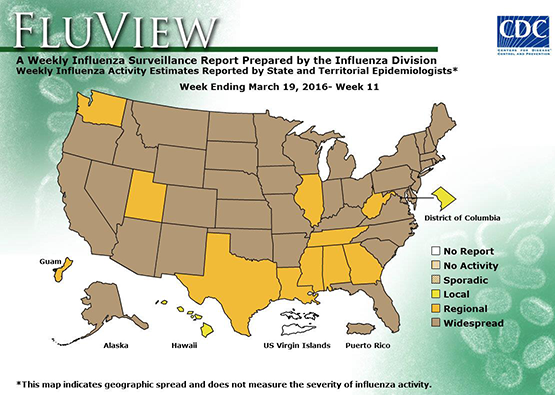
| March 2016 | |||||||||||
| Top stories | |||||||||||
| In the news | |||||||||||
| Photos | |||||||||||
| Contact us | |||||||||||
| Archive | |||||||||||
|
Influenza cases decline in Iowa |
Influenza cases and associated hospitalizations are on the decline in Iowa. Although influenza remains widespread throughout the state, the number of cases peaked in the week ending March 12. This matches national patterns noted in the weekly U.S. Influenza Surveillance Report.

The State Hygienic Laboratory confirmed 36 cases of influenza A and 10 cases of influenza B for the week of March 12, and only 18 cases of influenza A and eight cases of influenza B for the following week of March 19.
“Nationwide, influenza activity this season has been milder with fewer hospitalizations and deaths than the previous year,” said Wade Aldous, Disease Control Division director.
“The 2014-15 vaccine had an effectiveness rate of 23 percent, while the 2015-16 vaccine effectiveness was estimated to be around 60 percent. This higher rate is similar to past seasons when the vaccine was well-matched to circulating strains.
“CDC monitors vaccine effectiveness annually through the Influenza Vaccine Effectiveness (VE) Network. Estimates are reported annually, and often, an early estimate is reported during the season. Because the match between circulating and vaccine viruses is not known before the season, annual estimates of vaccine effectiveness give a real-world look at how well the vaccine protects against influenza caused by circulating viruses each season.”
The State Hygienic Laboratory tracks the influenza activity as part of the Iowa Influenza Surveillance Network managed by the Iowa Department of Public Health. Testing results from the Hygienic Laboratory are part of a weekly CDC national flu activity report.
The Hygienic Laboratory has confirmed four different influenza viruses circulating in Iowa: influenza A (H3), influenza A (H1N1), influenza B (Victoria) and influenza B (Yamagata).
Nationwide influenza activity this season has been milder with fewer hospitalizations and deaths than the previous year.
In addition to vaccination, the spread of influenza can be reduced by washing hands frequently, covering coughs and sneezes, and staying home when ill. Anti-viral medications are another defense for people at highest risk of developing more severe illnesses. Antivirals work best if started within 48 hours of when symptoms begin.